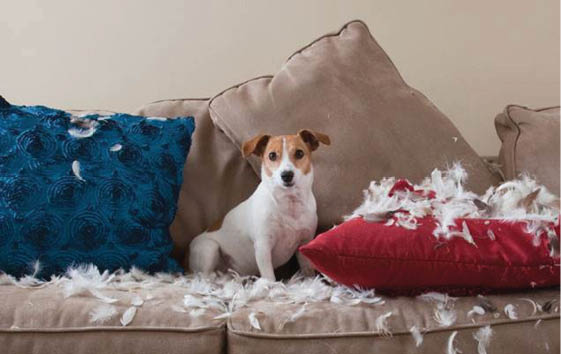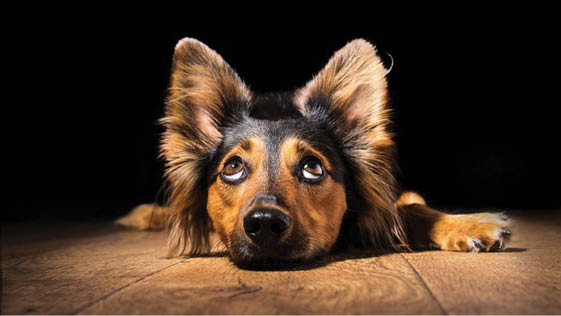Shirin Merchant is India’s pioneering Canine Behaviourist and Trainer. For the past 25 years, she has worked hard to ensure that dogs in India are trained using reward-based methods. 
A year ago, when the pandemic struck, it changed our lives and those of our dogs’ too. We were all stuck at home and many dogs enjoyed the constant attention that they received. But this constant access to the family became a problematic basis for many pet-parents and I started to hear complaints… “My dog keeps following me from room to room,” “My dog has become clingy – he wasn’t like this before!” and “My dog starts crying even if I go out for a short while now!”
With the lockdown having eased a few months ago, the complaints from the dogs and the pet-parents grew louder – “My dog will howl if left alone,” or “My dog shreds up the sofa if I step out!” If you have a dog that got clingy during the lockdown, you are likely struggling to leave your dog alone at home. So what can you do to help your dog?
First, we need to understand that ‘Separation Anxiety’ – a condition wherein an animal exhibits symptoms of anxiety or excessive distress when they are left alone – is a genuine condition and not something that dogs conjure up just to irritate us. Separation Anxiety symptoms can include destruction, soiling the house, barking, pacing, panting, salivating, trying to escape from the environment and even self-mutilation.
 So, what causes a dog to suffer from separation? Why is it that some dogs develop the condition and others don’t? We do know that in the wild, it is natural for young mammals to experience anxiety when separated from their mothers and siblings – it’s an adaptive survival mechanism. A pup that gets separated from his family, cries in distress, enabling mom to easily find him and rescue him.
So, what causes a dog to suffer from separation? Why is it that some dogs develop the condition and others don’t? We do know that in the wild, it is natural for young mammals to experience anxiety when separated from their mothers and siblings – it’s an adaptive survival mechanism. A pup that gets separated from his family, cries in distress, enabling mom to easily find him and rescue him.
Often, separation anxiety can also manifest in dogs that were separated too early from their mothers, or dogs that have never been taught to be alone at a young age, or even dogs that had a traumatising incident when left alone in the past or then, a dog that is over-bonded to one person at home. But currently, the main reason we experience it is due to the constant access dogs have had with their pet parents, who had to constantly stay indoors, due to the lockdown.
So, what can we do to lessen or prevent this Separation Anxiety problem if it exists?
- Don’t allow your dog to follow you from room to room: If your dog has constant access to you, he won’t know how to be by himself. It’s perfectly fine to go into a room and ask your dog to wait outside. He doesn’t need to stick to you 24/7.
- Preferably, don’t allow your dog to sleep in bed with you: While it’s true that sleeping in the owner’s bed won’t cause separation anxiety, if your dog already suffers from the issue, all of that nighttime closeness won’t help. After all, the goal is for your dog to learn to feel relaxed when alone, and if he can’t even be physically separated from you overnight, how can he remain calm by himself during the day when you’re gone? You can put his bed in your room and ask him to be there during the night, but not let him sleep with you in your bed.
- Avoid being too clingy with your dog: If you are constantly touching your dog, talking to him or engaging in any way, it can cause the dog to get used to it. Keep in mind that a clingy human often accompanies an insecure dog. Try ignoring your dog for a few hours at a stretch everyday; detach mentally, keep yourself occupied with other activities like painting or cooking, dancing or anything that doesn’t include your dog.
- Spend time with your dog in a positive creative way: It’s not the quantity that matters, but the quality of time you spend with your pooch. Play games, do training, go for a walk, etc. Do not play or engage all the time just because you have the time.
- Allow your dog to be by himself: Alone time is good for your dog and for you. It can rest his mind and help him enjoy his own company. Ensure there are a few hours every day, where he gets to be by himself and rests or occupies his mind creatively, at such time. It can be overwhelming to constantly be around others.
- Teach your dog to go to a designated place and relax: Practice a ‘Go to bed’ command. And slowly, increase the time, your dog stays there. You can eventually progress to asking your dog to stay there and going out of sight for short periods. Make sure your dog is happy by himself, and not scared, all through.
- Reduce general levels of stress in your dog: We all know stress contributes and exacerbates underlying issues. A stressed dog, when left alone, is far more likely to become anxious. Learn the indicators of stress and work on reducing the causes.
- Build confidence in your dog: Confident dogs tend to be more secure about being alone. Scenting games, fun training using positive methods, playing tug, and other games that stimulate the dog’s mind, are a great way to get your dog to become more confident.
- Be careful about reinforcing unwanted behaviour: If you go to the bathroom and your dog whines outside, and should you open the door and allow your dog inside, you could well be rewarding unwanted behaviour! So, be careful to encourage only the calm and happy behaviour of your doggy.
- Understand that your dog’s difficult behavior is not deliberate: And that punishment is ineffective, inappropriate, and will only exacerbate the behavior.
With any behaviour issue in a dog, it’s always better to prevent a problem than to allow it to grow and then try to remove/ correct it. If your dog has been showing signs of anxiety when alone, use the steps above to help him cope! In case of extreme anxiety, do get a professional to help bring back your doggy and you to a place of calm and happy!
- The Dark Side Of Pampered Pets: Is Your Kindness Harming Your Dog? - 16 March2024
- Kids And Preventing Dog Bites - 18 March2023
- Ordinary Dogs With Extraordinary Jobs - 13 August2022
